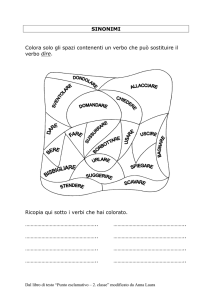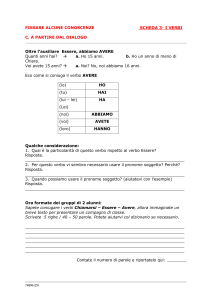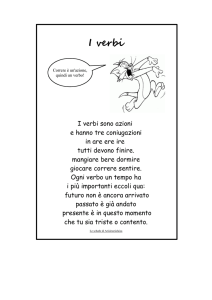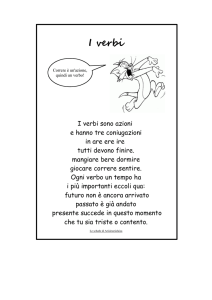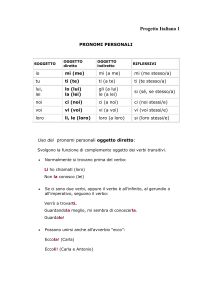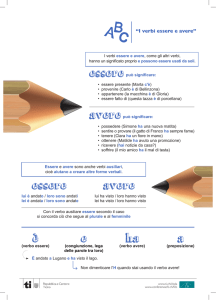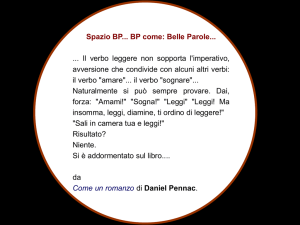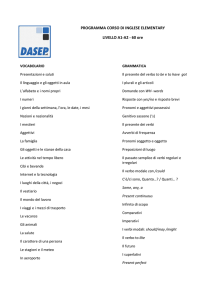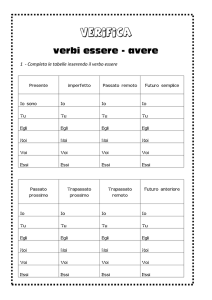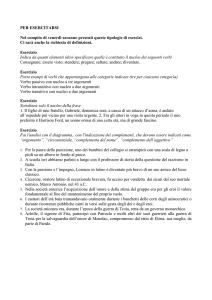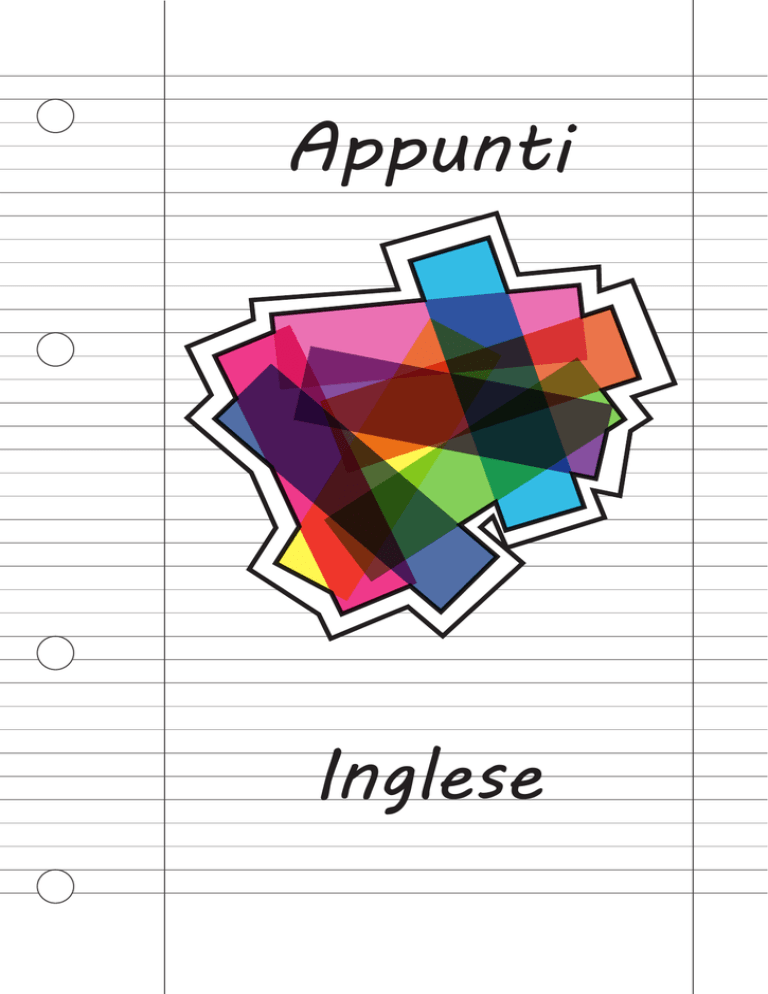
Appunti
Inglese
INDICATIVO/PRESENTE VERBO ESSERE – TO BE
I am – io sono
you are – tu sei
he/she/it is – egli/ella/esso è
we are – noi siamo
you are – voi siete
they are – essi sono
INDICATIVO/PRESENTE VERBO AVERE – TO HAVE
I have- io ho
you have – tu hai
he/she/it haS – egli/ella/esso ha
we have – noi abbiamo
you have – voi avete
they have – essi hanno
NB. Ricorda la S alla terza persona singolare.
INDICATIVO/PRESENTE VERBO REGOLARE (es. CHIAMARE – TO CALL)
I call – io chiamo
you call – tu chiami
he/she/it callS – egli/ella/esso chiama
we call – noi chiamiamo
you call – voi chiamate
they call – essi chiamano
NB. Ricorda la S alla terza persona singolare.
PAST SIMPLE: corrisponde al passato remoto/imperfetto italiano.
Per i verbi REGOLARI si forma aggiungendo -ED alla fine del
verbo.
Per i verbi IRREGOLARI si deve guardare la seconda colonna
dei verbi irregolari.
Uso il PAST SIMPLE per azioni passate e finite. Quando trovo
i complementi di tempo YESTERDAY, LAST WEEK, LAST
MONTH, LAST YEAR, 2 YEARS AGO, ecc.
PAST SIMPLE VERBO ESSERE – TO BE
I was – io ero
you were- tu eri
he/she/it was – egli/ella/esso era
we were – noi eravamo
you were – voi eravate
they were – essi erano
PAST SIMPLE VERBO AVERE – TO HAVE
I had – io avevo
you had - tu avevi
he/she/it had – egli/ella/esso aveva
we had – noi avevamo
you had – voi avevate
they had – essi avevano
PAST SIMPLE VERBO REGOLARE (es. CHIAMARE – TO
CALL)
I callED – io chiamai
you callED – tu chiamasti
he/she/it callED – egli/ella/esso chiamò
we callED – noi chiamammo
you callED – voi chiamaste
they callED – essi chiamarono
PAST SIMPLE VERBO IRREGOLARE (es. ANDARE – TO
GO/WENT → II colonna)
I went – io andai
you went – tu andasti
he/she/it went – egli/ella/esso andò
we went – noi andammo
you went – voi andaste
they went – essi andarono
NB. Il verbo coniugato al PAST SIMPLE non vuole la S alla
terza persona singolare.
PRESENT CONTINUOUS
Il presente continuo o progressivo si forma con il presente
dell’ausiliare essere più il verbo nella forma -ING (GERUNDIO, es. io sto mangiaNDO una mela → I am eatING an apple.)
-citazione prof. ARNEDA “mangiaNDO, NDO NDO NDO,
ING ING ING!”
Sono obbligato ad usare il presente continuo quando trovo
complementi di tempo quali: NOW, IN THIS MOMENT, ecc.
quindi indica un’azione che si sta svolgendo.
es. Ora gioco. / Ora sto giocando. → Now I am playing.
PRESENT PERFECT
Quando in italiano ho un passato prossimo, in inglese lo traduco con l’ausiliare avere, più participio passato (verbi regolari
-ED al verbo, verbi irregolari terza forma del paradigma). In
inglese traduco obbligatoriamente con il present perfect, quando ho un complemento di tempo tipo: THIS WEEK, THIS
YEAR, THIS MORNING, ecc., quindi l’azione NON è ancora
finita o non è definita.
es. Quest’anno sono andato al mare. → This year I HAVE
GONE (verbo irregolare: to go, went, GONE) to the seaside.
es. Sei mai stato a Londra? → HAVE you ever BEEN (verbo
irregolare: to be, was/were/ BEEN) to London.
FUTURO
1. Il futuro si forma con l’ausiliare WILL più il verbo all’infinito
senza TO.
WILL + INFINITO SENZA TO
es. Io andrò a casa → I WILL GO to home.
I will go – io andrò
you will go – tu andrai
he/she/it will go – egli/ella/esso andrà
we will go – noi andremo
you will go – voi andrete
they will go – loro andranno
2. Il futuro intenzionale, quando ho intenzione di compiere
un’azione si traduce con la formula “TO BE GOING TO”
es. Mangerò una mela. / Ho intenzione di mangiare una mela.
→ I’m going to eat an apple.
3. Il futuro immediato indica un’azione che sta per compiersi,
che è sul punto di attuarsi. Lo traduco con il present continuous, quindi si forma con il presente dell’ausiliare essere più il
verbo nella forma -ING.
es. Uscirò. / Sono sul punto di uscire. → I am going out. [TO
GO OUT = USCIRE]
DOPPIO FUTURO
Quando ho due frasi al futuro (una principale e una secondaria), in inglese lascio la frase principale al futuro e traduco la
frase secondaria al presente.
es. Uscirò (← Principale) - quando avrò tempo (← Secondaria)
I WILL go out – when I HAVE time
es. Se leggerai (← Secondaria) – imparerai (← Principale)
If you READ – you WILL learn.
PS. Come capire se si tratta di una frase principale e seconda-
ria? La frase principale è sempre la parte che ha un senso anche da sola, senza la secondaria. (es. Se leggerai → non ha senso
da sola. Imparerai → ha senso da sola, quindi è la frase principale.)
CONDIZIONALE
-Il condizionale presente si forma con WOULD + infinito del
verbo senza TO.
es. Io andrei a casa. → I WOULD go to home.
-Il condizionale passato si forma con WOULD + HAVE +
PARTICIPIO PASSATO (per i verbi regolari -ED, per i verbi
irregolari guardo la terza colonna)
es. Io sarei andato → I WOULD HAVE GONE (verbo irregolare: to go, went, GONE)
es. Io avrei giocato → I WOULD HAVE playED (verbo regolare)
CONGIUNTIVO
Il congiuntivo in inglese “non esiste”, lo traduciamo con il
modo indicativo.
(Conginutivo presente = Indicativo presente)
es. Che io vada. → I go.
es. Che io sia andato. → I have gone. (Present Perfect)
es. Se andasse. → If he went.
es. Se fosse andato. → If he had gone (Past Perfect)
NB. Il congiuntivo passato/imperfetto del verbo TO BE, indipendentemente dai IF (se) è WERE per tutte le persone.
es. Se IO fossi simpatico. → If I WERE nice.
es. Se LUI fosse simpatico. → If HE WERE nice.

